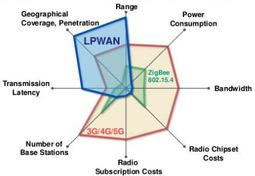5G IoT Architecture: Advantages and Challenges
Advertisement
This article covers the 5G IoT Architecture and the IoT requirements that are fulfilled by the 5G network. It discusses the benefits/advantages and challenges/drawbacks of the 5G IoT architecture.
Introduction
5G is the fifth generation wireless technology and follows 3GPP specifications. It’s the successor to 4G LTE technology. The first 5G specifications were published by 3GPP in Dec. 2017.
5G is used across various industries such as health, utility, telecom, automotive, public safety, etc., for different applications. All these applications fall under one of the 5G service classes viz. eMBB, mMTC, and URLLC.
One such application is IoT (Internet of Things). IoT can be defined as an internet technology which connects devices, machines, and tools to the internet by means of wired and wireless technologies such as Bluetooth, WiFi, Zigbee, LoRa, GSM, LTE, 5G, etc.
IoT allows objects to be sensed and/or controlled remotely across existing networks. IoT improves efficiency, accuracy, and economic benefits in addition to reduced human intervention. IoT unifies multiple technologies such as embedded systems, indoor wireless systems, cellular systems, cloud computing, machine learning, big data, data analytics, networking, and so on.
IoT solutions allow connections of utility meters, light poles, traffic lights, surveillance cameras, temperature sensors, etc. to the internet. This category of use case connects thousands of devices and is known as Massive IoT. The 5G technology enables industries and societies to rollout this 5G IoT use case. The other IoT use cases enabled by 5G include smart communities, autonomous cars, industrial IoT, smart homes, robotic surgeries, remote health monitoring, surveillance, etc.
IoT network needs the following requirements to be met by a supporting cellular network:
- Wireless connectivity to connect IoT devices
- Availability of network coverage everywhere to support movable IoT devices
- Support for higher downlink (gNB to UEs) and uplink (UEs to gNB) speed
- Long life battery on devices, one example is a smart water meter which once deployed does not require frequent changes of batteries
- Scalable network to support thousands of devices
- Network with low latency support for AR/VR applications

Figure-1: 5G network architecture
The figure-1 depicts 5G NR (New Radio) network architecture with its elements.
The 5G wireless technology addresses all the above requirements of IoT networks as described below:
- High Speed Broadband (> 1 Gbps), Example: Surveillance cameras stream live video feeds to edge cloud location
- Massive Machine Type Communications (mMTC) to support connections of massive IoT devices with 5G towers, Examples: smart utility meters, street lights, health gadgets
- Ultra Reliable Low Latency Communications (URLLC) to offer network latency in sub-milliseconds with error rates lower than 1 in 10^5 packets, Example: Autonomous cars
Overview of 5G IoT architecture

Figure-2: 5G IoT architecture
The figure-2 depicts the use of a 5G gNB (i.e., Base Station) connecting various IoT devices either directly or through a local IoT gateway. The IoT gateway supports various protocols such as WiFi, Bluetooth, Zigbee, or LoRa. IoT devices supporting any one of these technologies can easily connect with the IoT Gateway, which allows further connectivity with the 5G cellular tower.
Autonomous car use cases require very low latency and hence connect directly with the 5G gNB tower, which is interfaced with the cloud through edge compute and 5G core network (CN). Applications running in the cloud can utilize 5G service via the Core network (CN) as shown in the figure.
Advantages of 5G IoT Architecture
Following are the benefits or advantages of the 5G IoT architecture:
- It offers high-speed wireless data connections for IoT devices. Data rates of 10 Gbps and above are supported by 5G technology.
- It offers a scalable wireless network with support for wider bandwidth to support a growing number of IoT devices.
- It supports latency of less than 1 ms to provide immediate connectivities to IoT devices.
- It offers smooth handoff to provide uninterrupted network coverage.
- Energy-efficient IoT devices, together with 5G, provide long battery life for low maintenance devices such as utility meters for water and electricity, surveillance cameras, street lights, light poles, etc.
- 5G supports varying data transfer speeds of different IoT devices. Smart utility meters send readings to the cloud once per day or hour. Surveillance cameras send video feeds to the cloud continuously. Some IoT devices transmit data to the cloud asynchronously as per trigger of the event.
Challenges of 5G IoT Architecture
Following are the challenges or drawbacks of the 5G IoT architecture:
- IoT devices are growing drastically which requires massive data transfer using 5G or other cellular connections in real-time. It is a challenge to store this huge volume of different types of data (images, files, videos, etc.) originated from various IoT devices. Data analytics methods are also needed to analyze complex patterns of data over time and to determine the frequency of IoT sensors readings.
- The interoperability issues of different kinds among IoT devices using cellular connections and indoor wireless connections are a major concern in the cellular IoT domain. The interoperability issues occur due to different manufacturers, different operating systems, versions, frameworks, communication protocols, etc.
- Security and privacy of user data transported over 5G IoT architecture is a crucial issue. Various methods and procedures are adopted to deal with these issues.
- Scalability of the network and its bandwidth management is a major concern due to different IoT devices requiring varying data transfer speeds as per their applications or usages.
- Lack of IoT standards is another major challenge. It solves many of the problems faced while configuring and managing a large number of IoT devices.
- Legal and regulatory policies are required to be updated as the technology matures.
Conclusion
5G offers higher speed, reduced latency, and higher connection density with several thousands of connections. IoT devices consume very low power and hence the 5G IoT network can become a reality for consumer and industrial IoT applications.
Advertisement
 RF
RF



